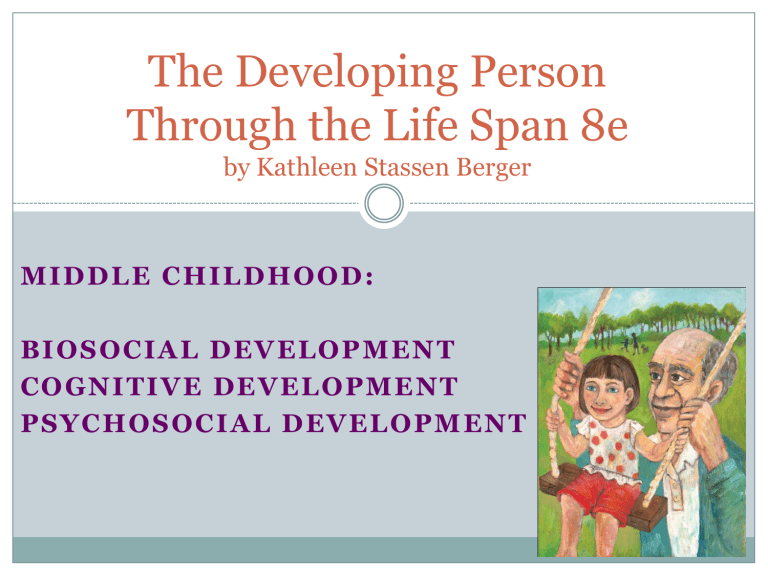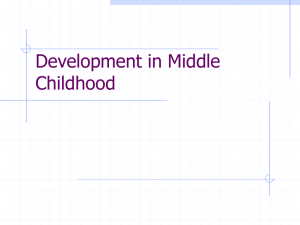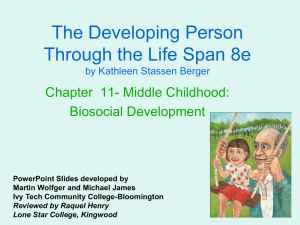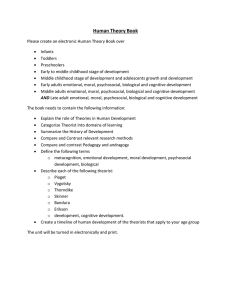The Developing Person Through the Life Span 8e MIDDLE CHILDHOOD: BIOSOCIAL DEVELOPMENT

The Developing Person
Through the Life Span 8e
by Kathleen Stassen Berger
MIDDLE CHILDHOOD:
BIOSOCIAL DEVELOPMENT
COGNITIVE DEVELOPMENT
PSYCHOSOCIAL DEVELOPMENT
Slower Growth, Greater Strength
Growth is slow and steady; self-care is easy
Children depend less on their families
Muscles become stronger, can run faster
Are able to eat enough, or too much
Earlier malnutrition is evident in height
Improved medical and oral care in the U.S.
Adult Teeth
Health Problems in Middle Childhood
Childhood Obesity
Body mass index (BMI)- A person ’ s body weight in kilograms divided by the square of height in meters.
Overweight- In a child, having a BMI above the 85 th percentile.
Obesity- In a child, having a BMI above the 95 th percentile. Heredity: can be genetically predisposed
Causes
Parenting: too much T.V., drink soda, no exercise, poor family eating habits
Social influences: school lunches, snack machines, subsidies for corn oil but not fresh veggies, food advertising, etc.
Health Problems in Middle Childhood
Asthma
A chronic inflammatory disorder of the airways that makes it difficult to breathe.
Signs and symptoms include wheezing, shortness of breath, chest tightness, and coughing.
Approximately 6 million children in U.S. have asthma
Asthma is the most common chronic disease among children - especially children who have low birth weight, are exposed to tobacco smoke, are black, and are raised in a low-income environment.
Prevention of Asthma
Primary: changes in society such as better ventilation, less pollution, etc.
Secondary: decrease among high- risk children by family exercise, less dust, smoke and cockroaches, breast-fed as infants
Tertiary: prompt use of injections, inhalers and hypoallergenic materials
Brain Development
Maturing corpus callosum helps balance and two-handed coordination
Myelination speeds up thought & behavior
Prefrontal cortex begins to plan, monitor and evaluate
Brain Development
Reaction time: time it takes to respond to a stimulus physically or cognitively
Selective attention: ability to concentrate on some stimuli while ignoring others
Automatazation: process in which repetition of a sequence of thoughts & actions makes the sequence routine
Measuring the Mind
Aptitude: The potential to master a specific skill or to learn a certain body of knowledge.
IQ test: A test designed to measure intellectual aptitude.
Achievement test: A measure of mastery or proficiency in reading, mathematics, writing, science, or some other subject.
Measuring the Mind
The most important aptitude for school-age children is intellectual aptitude, or the ability to learn in school, which is usually measured by an IQ test.
Flynn effect - The rise in average IQ scores that has occurred over the decades in many nations.
Criticisms of Testing
No test can measure the complexities of the human brain
Studies show that people inherit a set of abilities and not a general intellectual ability
Scores on tests change
Multiple Intelligences
Robert Sternberg (1996):
− Academic: IQ and achievement tests
− Creative: imaginative endeavors
− Practical: everyday problem solving
These are significant in adulthood when practical intelligence is more relevant than academic intelligence.
Howard Gardner (1983, 1999, 2006)
− 9 intelligences: linguistic, logical-mathematical, musical, spatial, kinesthetic, interpersonal, intrapersonal, naturalistic, existential
− people excel in some more than others
− influential in education, especially with children
Children with Special Needs
Developmental Psychopathology
Links the study of typical development with the study of disorders.
Comorbid-presence of 2 or more unrelated disease conditions at the same time in the same person
(i.e. ADHD & Oppositional Defiant Disorder)
Two Basic Principles:
Multifinality one cause may have multiple manifestations.
example: child flooded with stress hormones in infancy, hypervigilant or unusually calm, easily angered or quick to cry.
Equifinality one manifestation has many causes.
example: 2 year old who doesn’t talk may be autistic, hard of hearing, mentally retarded, electively mute
Children with Special Needs
Attention-deficit/hyperactivity disorder (ADHD): inattentive, impulsive, and overactive and thus has great difficulty concentrating
Bipolar disorder: extreme mood swings that are not caused by outside experiences.
Learning disability:
A marked delay in a particular area of learning that is not caused by an apparent physical disability, by mental retardation, or stressful home environment.
Dyslexia:
Unusual difficulty with reading; may be neurological underdevelopment.
Dyscalculia: Unusual difficulty with numbers.
Autism: inability to relate to other people normally, extreme self-absorption, inability to acquire normal speech.
Autistic spectrum disorder:
Any of several disorders characterized by impaired communication, inadequate social skills, and unusual patterns of play.
Asperger syndrome- disorder characterized by extreme attention to details and deficient social understanding.
Special Education
Whether a child is designated as needing special education is not straightforward
Changing laws and practices:
−least restrictive environment (LRE)
−response to intervention
−individual education plan (IEP)
Laws & Special Needs
Cognitive Development
Middle Childhood
Piaget’s Stages of Cognitive Development
Ages 7 - 11 years old
Concrete operational thoughtthe ability to reason logically about direct experiences and perceptions.
Includes cause-and-effect.
Classification- things can be organized into groups (or categories or classes) according to some characteristic they share.
Transitive inference- the ability to figure out
(infer) the unspoken link (transfer) between one fact and another.
Piaget’s Stages of Cognitive Development
Conservation
The understanding that although an object’s appearance changes, it still stays the same in quantity. Redistributing an object does not affect its mass, number, or volume.
Mathematical Transformation
(5+2=7; 7-5=2)
Seriation –
The idea that things can be arranged in a series.
crucial for understanding the number sequence.
School-age children can use mental categories and subcategories more flexibly, inductively, and simultaneously than younger children.
Vygotsky’s Sociocultural Theory
Vygotsky regarded instruction as essential.
Children are "apprentices in learning" as they play with each other, watch television, eat dinner with their families, and engage in other daily interactions.
Language is integral as a mediator, a vehicle for understanding and learning.
Information Processing
Like computers people take in information and then:
−seek specific units of information
−analyze the information
−express their conclusions
The brain ’ s gradual growth confirms the information-processing perspective.
Requires memory:
Sensory memory- Incoming stimulus information is stored for a split second to allow it to be processed. (Also called the sensory register.)
Working memory- Current, conscious mental activity occurs. (Also called
short-term memory.)
Long-term memory- Virtually limitless amounts of information can be stored indefinitely.
Memory
Memory
Working memory improves steadily and significantly every year from age 4 to 15 years.
The capacity of long-term memory is virtually limitless by the end of middle childhood.
Memory storage (how much information is deposited in the brain) expands over childhood, but more important is
retrieval (how readily stored material can be brought into working memory).
Metacognition- "Thinking about thinking"; the ability to evaluate a cognitive task in order to determine how best to accomplish it, and then to monitor and adjust one ’ s performance on that task.
Knowledge base- a body of knowledge in a certain area that makes it easier to master new information in that area
Control Processing
-
Mechanisms (selective attention, emotional
regulation) that combine memory, processing speed, and knowledge to regulate the analysis and flow of information within the system.
Language
By age 6, children know most of the basic
vocabulary and grammar of their first language, and many speak a second or even a third language.
Some school-age children learn as many as 20 new words a day and apply grammar rules they did not use before.
Adjusting Vocabulary to the Context
Pragmatics- ability to adjust language communication according to audience and context.
This advances quite a bit in middle childhood.
Each code differs in tone, pronunciation, gesture, sentence length, idiom, grammar, and vocabulary.
Sometimes people switch from the formal code (used in academic contexts) to the informal code (used with friends).
Many children use a third code in text messaging, with numbers (411), abbreviations (LOL), and emoticons .
Differences in Language Learning
Family poverty
Research shows a strong correlation between academic
achievement and socioeconomic status
− language exposure
− adult expectations
− resources
Hidden curriculum -
The implicit rules and priorities that influence the academic curriculum and every other aspect of learning in school
Learning in a Second Language
Learning a Second Language
Immersion - all subjects are taught in the child ’ s second language
Bilingual schooling- Subjects are taught in the child ’ s original and second languages
ESL- children who do not speak English are taught together in an intensive class to learn basic English so they can be mainstreamed later
International Tests
U.S. children tend not to do well on international tests
No Child Left Behind Act
(2001): a U.S. law intended to increase accountability in education by having states qualify for federal money based on standardized tests
In the United States
NAEP: an ongoing, nationally representative measure of U.S. children ’ s achievement in reading, math, etc.
Reading Wars
Phonics approach - Teaching reading by first teaching the sounds of each letter and letter combinations.
Whole-language approach - Teaching reading by encouraging early use of all language skillstalking, listening, reading, and writing
Psychosocial Development
The Nature of the Child
Erikson ’ s Psychosocial
Development
Industry versus inferiority
• The fourth of Erikson ’ s eight psychosocial crises
• Children attempt to master many skills, developing a sense of themselves as either industrious or inferior, competent or incompetent.
Freud on Latency
Latency
• Emotional drives are quiet and unconscious sexual conflicts are submerged.
• Sexual energy is channeled into social concerns.
Self-Concept
Social comparison
Comparing one ’ s attributes to those of other people
Self-criticism and self-consciousness rise from ages 6 to 11
Materialism increases
Complications of
Unrealistic Self-Esteem
Effortful control: the ability to regulate one ’ s emotions and actions through effort.
reduced with unrealistically high self-esteem
After-school activities can help provide a foundation for friendship and realistic self-esteem
Resilience and Stress
Resilience: The capacity to adapt well despite significant adversity and to overcome serious stress.
1.Resilience is dynamic - a person may be resilient at some periods but not at others.
2.Resilience is a positive adaptation to stress - if rejection by a parent leads a child to establish a closer relationship with another adult, that child is resilient.
3.Adversity must be significant - Resilient children overcome conditions that overwhelm many of their peers.
Social Support
Grandparents, teachers, unrelated adults, peers, and pets help children cope with stress.
Community institutions (e.g. churches, libraries) can also be crucial sources of social support.
Families and Children
Shared and Nonshared Environments
Genes affect half or more of the variance for almost every trait
Environment:
Influence of shared environment (e.g., children raised by the same parents in the same home) shrinks with age
Effect of nonshared environment (e.g., friends or schools) increases
Children raised in the same households by the same parents do not necessarily share the same home environment.
Family Function and Family Structure
Family structure:
The legal and genetic relationship among relatives living in the same home; includes nuclear family, extended family, stepfamily, and so on.
Family Structure and Family Function
Family Function:
The way a family works to meet the needs of its members.
1.
2.
3.
Children need families to: provide basic material necessities encourage learning help them develop self-respect
4.
5.
nurture friendships foster harmony and stability
Family Function and Family Structure
Children in middle childhood prefer continuity
•
Upsetting changes include moving to a new home, being sent to a new school, and changes in the family structure
•
Adults might not realize that these transitions affect schoolchildren
Family Trouble
Family-stress model: the crucial question to ask about any risk factor (e.g. poverty, divorce, job loss, eviction) is whether or not it increases the stress on a family
•
The family-stress model contends that the adults ’ stressful reaction to poverty is crucial in determining the effect on the children.
Family Trouble
Children feel a need for harmony
•
•
•
Parents who habitually fight are more likely to divorce, move, and otherwise disrupt the child ’ s life.
Remarriage of divorced parents is often difficult for children due to jealousy, stress, and conflict.
Children frequently suffer if parents physically or verbally abuse each other.
The Peer Group
Culture of children: The particular habits, styles, and values that reflect the set of rules and rituals that characterize children as distinct from adult society.
•
•
•
Fashion
Language
Peer culture
Older children:
Demand more of their friends
Change friends less often
Become more upset when a friendship ends
Find it harder to make new friends
Seek friends who share their interests and values
Popular and Unpopular Children
Aggressive-rejected: Children who are disliked by peers because of antagonistic, confrontational behavior
Withdrawn-rejected: Children who are disliked by peers because of their timid, withdrawn, and anxious behavior
Bullies and Victims
Bullying: Repeated, systematic efforts to inflict harm through physical, verbal, or social attack on a weaker person.
Bully-victim: Someone who attacks others and who is attacked as well
Also called a provocative victim because he or she does things that elicit bullying, such as stealing a bully ’ s pencil
Stopping Bullying
The whole school must be involved, not just the identified bullies.
Intervention is more effective in the earlier grades.
Evaluation is critical.
Children ’ s Moral Values
Kohlberg ’ s Levels of Moral Thought
Lawrence Kohlberg (1963) described stages of morality stemming from three levels of moral reasoning, with two stages at each level:
1.
Preconventional moral reasoning: Emphasizes rewards and punishments
2.
Conventional moral reasoning: Emphasizes social rules
3.
Postconventional moral reasoning: Emphasizes moral principles
4.
http://www.youtube.com/watch?v=GTzBrjxKHLg





